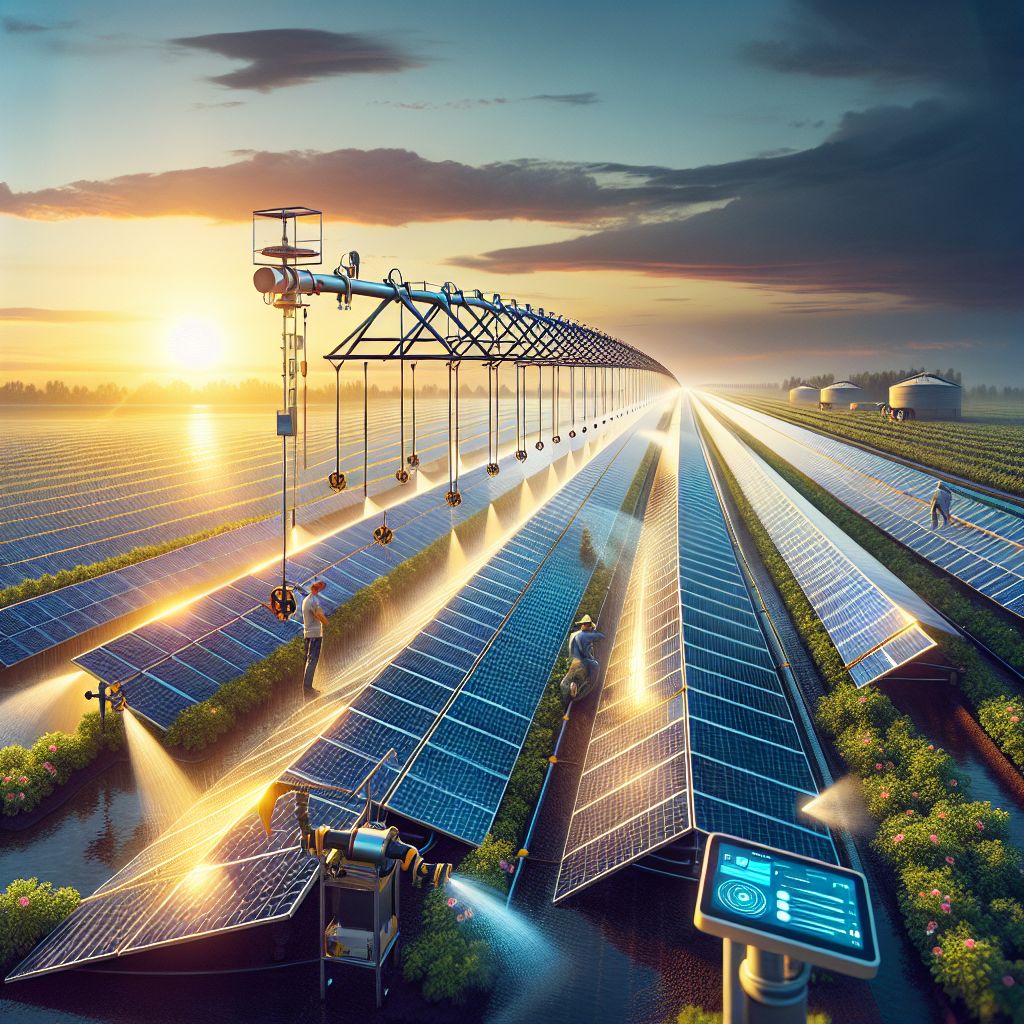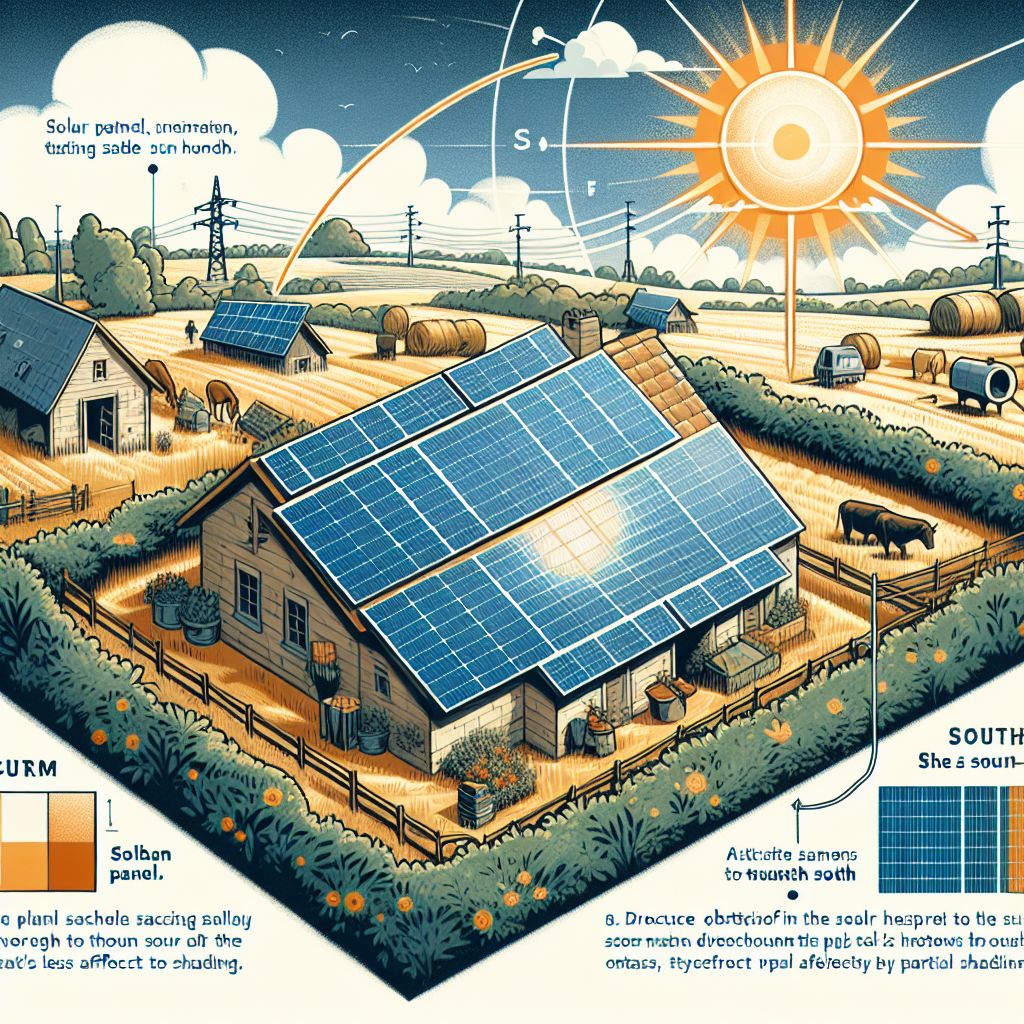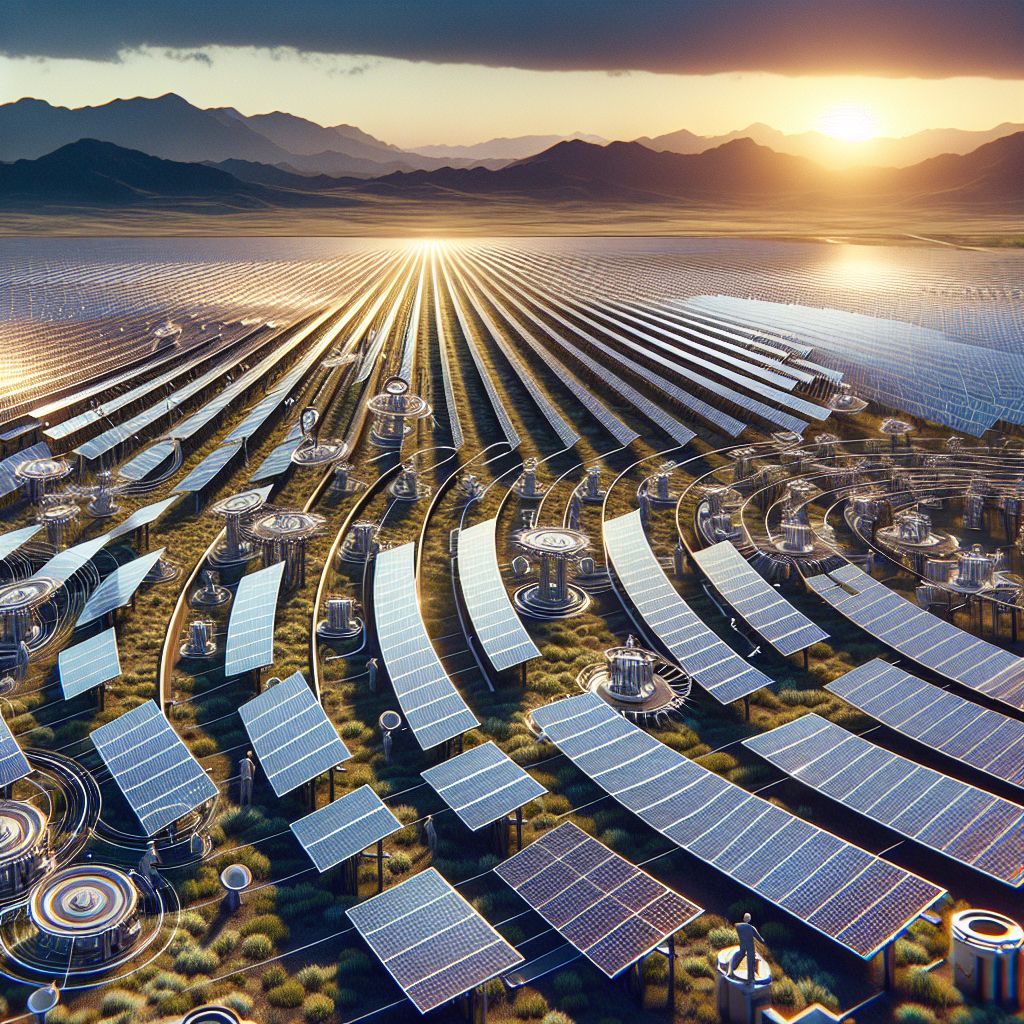
Key Takeaways
-
Understanding the optimal angle for solar panels is crucial for maximizing energy absorption and irrigation system efficiency on farms.
-
Latitude and seasonality play significant roles in determining the best tilt angle for solar panels.
-
Proper orientation of solar panels—typically southward in the northern hemisphere—can significantly increase energy production.
-
Adjustable and tracking solar panel systems can provide even higher efficiency but require a cost-benefit analysis.
-
Regular maintenance and smart monitoring are key to sustaining the performance of solar panels on farms.
Soak Up the Sun: Solar Panel Placement for Maximum Harvest Power
Let’s dive right in: solar panels can be a game-changer for farms. They’re not just about being green; they’re about increasing efficiency and saving on energy bills. But to truly reap the benefits, it’s not enough to just slap some panels on the barn roof. You’ve got to get the angles and orientation just right. That’s where I come in. I’m here to show you how to harness the sun’s power to its fullest potential, specifically for your irrigation systems.
Why Solar Panel Angle Matters on the Farm
Think of solar panels like a sponge soaking up sunlight. The angle at which the sun’s rays hit the sponge determines how much water it absorbs. Similarly, the tilt of your solar panels is critical for capturing the maximum amount of sunlight. If the angle’s off, you’re leaving precious energy—and money—on the table. And for a farm, that energy translates directly into powering your irrigation systems, ensuring your crops get the water they need without draining your resources.
The Perfect Tilt: Finding Your Farm’s Sweet Spot
Now, you might be wondering, “What’s the perfect tilt for my panels?” Well, it’s not a one-size-fits-all answer. It depends on your farm’s latitude and the time of year. But don’t worry, I’ll walk you through it step by step. By the end of this guide, you’ll have all the info you need to position your panels for peak performance.

Calculating Your Farm’s Ideal Solar Panel Angle
First things first: your farm’s latitude is your starting point for figuring out the ideal angle. This is because the sun’s position in the sky changes with how far north or south you are. A simple rule of thumb is to set the tilt angle of your panels to match your latitude during the spring and fall equinoxes. But we’ll get more precise than that. Hang tight.
Latitude: Your Starting Point
Let’s break it down. If your farm sits at a latitude of 35 degrees, a good starting tilt angle for your panels is, you guessed it, 35 degrees. This angle is a solid baseline for when the sun is at its equinox, which happens twice a year—once around March 21 and again around September 21. These dates are when day and night are about equal, and the sun’s rays hit the Earth head-on at the equator.
Seasonal Adjustments for Optimal Exposure
But here’s the thing: as the seasons change, so does the sun’s path across the sky. To maximize your solar panel efficiency year-round, you’ll need to tweak the tilt angle as we move through the seasons. In summer, when the sun is higher in the sky, lower the angle slightly. In winter, when the sun is lower, increase the angle. This ensures your panels are always positioned to catch the most rays.

Making the Most of the Sun’s Path: Orientation Essentials
Orientation is another critical factor. It’s about which direction your panels face. In the northern hemisphere, the general rule is to point them south. This way, they get direct sunlight throughout the day. But, it’s not just about picking a cardinal direction. You want to consider the path of the sun across your specific piece of the sky. It’s not just about south; it’s about the best south for you.
East, West, South: Which Way to Face?
Here’s the breakdown: if your farm is in the northern hemisphere, aim for true south, not magnetic south. This ensures the panels get the most sun as it travels from east to west. For those down under, in the southern hemisphere, you’ll want to do the opposite and face your panels north. Now, if you have the option for dual-tilt or east-west configurations, you can catch the morning and afternoon sun even better, which can be especially useful during those shorter winter days.
Adjusting for Obstructions and Shading
Remember, it’s not just about the sun; it’s about what’s between the sun and your panels. Watch out for obstructions like trees or buildings that might cast shadows during the day. Even a small amount of shade can significantly reduce your panels’ efficiency. If you can’t remove the obstruction, consider adjusting the placement of your panels to sidestep the shade or using a different type of panel that’s less affected by partial shading.

Advanced Techniques: Tracking and Adjustable Panels
Now, for those of you looking to squeeze every drop of efficiency out of your solar setup, let’s talk about tracking and adjustable panels. These advanced systems can follow the sun’s path across the sky, adjusting the angle of your panels in real-time to optimize sunlight absorption. It’s like giving your panels a sun-chasing superpower.
Following the Sun: The Benefits of Tracking Systems
Tracking systems come in two flavors: single-axis and dual-axis. Single-axis trackers follow the sun from east to west, while dual-axis trackers also adjust for the sun’s seasonal variation in height. These systems can boost your energy production by up to 40%, which is a significant leap. They’re particularly beneficial for farms with limited land space, as they make every panel work harder.
Manual Versus Automatic: Which is More Efficient for Your Farm?
When it comes to tracking, you’ve got two choices: manual or automatic. Manual tracking means you adjust the panels yourself, which is more labor-intensive but less expensive upfront. Automatic tracking does all the work for you but comes with a higher price tag. The decision boils down to how much time you’re willing to invest versus how much money you’re willing to spend.
Real-Life Success: Solar Optimization in Action
Let’s look at some real-life examples. Farms across the world are harnessing the power of the sun more effectively than ever before, thanks to precise panel placement and orientation. These success stories aren’t just about the environment; they’re about the bottom line.
Case Study: Increased Yields with Precision Panel Placement
Consider a vineyard in California that adjusted its panel angles with the seasons. By doing so, they were able to power their irrigation systems entirely with solar energy, leading to a 20% increase in yields. The secret? They used data from their specific location to fine-tune their panel positions, ensuring maximum sunlight capture all year round.
Farmers’ Testimonials: Boosting Irrigation Efficiency Through Solar
And it’s not just big operations that benefit. A family-owned farm in the Midwest installed a small solar array with adjustable angles. They reported that their irrigation costs dropped by half during the peak summer months. Their testimonial? “Going solar was the best decision for our farm’s sustainability and our wallet.”

Sustaining Your Gains: Maintenance and Monitoring
Getting the right setup is just the start. To keep those panels performing at their best, regular maintenance is key. You wouldn’t let your tractor fall into disrepair, and the same goes for your solar panels. They need to be clean, clear, and well-connected to keep the energy flowing.
Routine Check-Ups: Keeping Your Panels at Peak Performance
“A stitch in time saves nine. Regular maintenance on your solar panels can prevent costly repairs down the line.”
Here’s what you should be doing: at least twice a year, give your panels a thorough inspection. Look for any dirt, debris, or damage. Clean them gently with water and a soft brush, and make sure all the connections are secure. This can prevent efficiency losses and extend the life of your panels.
And don’t forget about the wiring and inverters. They need a check-up too. Ensure there’s no corrosion and that all connections are tight. This helps prevent energy loss and potential hazards. It’s all about keeping the current strong and the power steady.
Smart Monitoring: Harnessing Technology for Better Solar Returns
Lastly, let’s talk tech. Smart monitoring systems can track your panels’ performance in real-time, alerting you to any issues before they become big problems. This technology can also help you see patterns in your energy production, allowing you to make adjustments for even better efficiency. It’s like having a personal energy assistant dedicated to your farm’s solar health.
Maximizing Return on Investment
Maximizing the return on investment for a solar irrigation system requires careful consideration of the angle at which the solar panels are installed. By regularly adjusting the angles to face the sun directly, farmers can increase energy production, prolong the lifespan of their panels, and ensure that their systems are operating at their maximum capacity. While this may require some initial effort and investment, the long-term benefits for both the farmer and the environment make it a worthwhile endeavor. As the demand for sustainable farming practices continues to grow, optimizing the angles of solar panels on irrigation systems is a crucial step towards a more sustainable future.
Cost-Benefit Analysis: Is Adjusting Panel Angles Worth It?
Investing in an adjustable-angle solar system might seem like a no-brainer for maximizing energy capture, but it’s essential to weigh the costs against the benefits. Let’s crunch some numbers. If your farm spends $1,000 on electricity monthly and an adjustable system boosts efficiency by 20%, that’s $200 saved per month. However, if the system costs $10,000 more than a fixed setup, it’ll take over four years to break even. So, consider your farm’s long-term plans and financial health before taking the plunge.
This below table show the Cost-Benefit Analysis for Adjusting Panel Angles with a Solar Irrigation System on a Farm:
|
Costs |
Benefits |
|---|---|
|
Initial setup costs for solar panels and irrigation system |
Lower energy costs for pumping water |
|
Maintenance costs for the system |
Improved energy production due to optimized panel angles |
|
Potential additional expenses for adjusting panel angles |
Potential increase in energy output and cost savings That turns into Potential increase in crop yield due to better irrigation efficiency |
Government Incentives and Grants for Solar Farming
Good news for your wallet: many governments offer incentives and grants to encourage solar farming. These can range from tax credits and rebates to subsidized loans. For instance, in the United States, the federal solar Investment Tax Credit (ITC) can cover 26% of your system’s cost. It’s like getting a quarter of your investment back just for going green. Always check local programs too—they can stack with federal incentives for even more savings.
Moreover, some regions provide grants specifically for agricultural solar projects. These grants may cover a significant portion of the costs, aiming to support farmers in adopting renewable energy. It’s worth investigating what’s available in your area and how these incentives can offset your initial outlay.
Remember, these incentives not only reduce your upfront costs but also accelerate the payback period for your investment. It’s a win-win: you’ll be saving money and the environment at the same time.
Frequently Asked Questions
Got questions? I’ve got answers. Here are some common queries I hear from farmers about solar panel angles and efficiency:
How often should solar panel angles be adjusted on a farm?
Ideally, solar panel angles should be adjusted at least twice a year, to account for the changing seasons. If you want to optimize even further, quarterly adjustments can capture the seasonal variations more accurately. But remember, the more you adjust, the more labor you’re committing. Balance is key.
For those with tracking systems, adjustments are continuous and automatic, so there’s no need for manual intervention. This convenience comes with a higher upfront cost but can lead to greater long-term savings and efficiency.
Can solar panels be too hot for efficient energy production?
-
Yes, solar panels can overheat, which ironically reduces their efficiency. Optimal operating temperatures are typically around 25°C (77°F).
-
If temperatures exceed this range, the panels’ efficiency can drop. This is known as the temperature coefficient, and it varies by panel type.
-
To mitigate heat, ensure there’s adequate air circulation around the panels and consider installing them at an angle, which naturally helps with cooling.
Remember, while solar panels love sunlight, they’re not fans of high heat. It’s a delicate balance, like making sure your crops get just enough water but not too much.
What is the best solar panel type for agricultural use?
For farms, the best solar panel type often depends on your specific needs and environment. Monocrystalline panels are highly efficient and space-saving, perfect if you’re short on room. Polycrystalline panels are more cost-effective and might be the way to go if you have more space and a tighter budget.
Are there any risks in using solar tracking systems?
Solar tracking systems are fantastic for maximizing energy production, but they come with moving parts, which means more potential points of failure. They can also be more susceptible to wind damage. It’s crucial to factor in these risks and ensure you have a robust maintenance plan in place.
How can I calculate the ROI for solar panels on my farm?
To calculate the ROI for solar panels on your farm, consider these factors:
-
The total cost of the solar panel system, including installation.
-
The amount of electricity the system is expected to produce, and the value of that electricity.
-
Any available government incentives or grants that will offset the initial cost.
-
The expected lifespan of the system and any maintenance costs.
Subtract the total costs from the total benefits over the lifespan of the system, and divide by the total costs to get the ROI percentage. It’s a simple calculation that can reveal the long-term value of your solar investment.
Conclusion: How Important is the Angle of the Solar Panel in its Overall Efficiency
In conclusion, the angle of your solar panel is a linchpin in your farm’s energy efficiency and productivity. Getting it right can mean the difference between just getting by and thriving. It’s about understanding the interplay between the sun’s path, your farm’s location, and the technology available to you. With the right setup, you can ensure your irrigation systems are powered sustainably, your energy bills are lower, and your farm’s footprint is as light as a feather on the earth.






